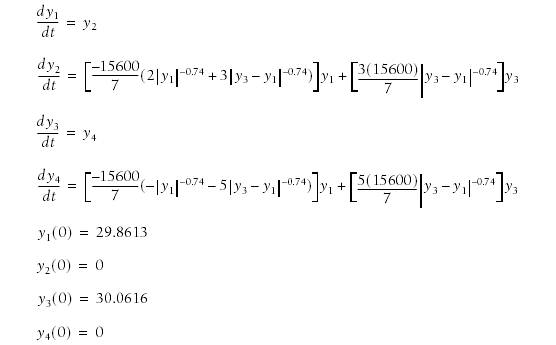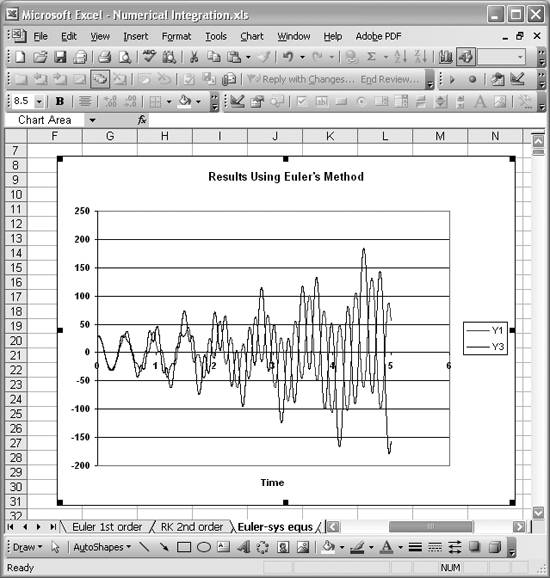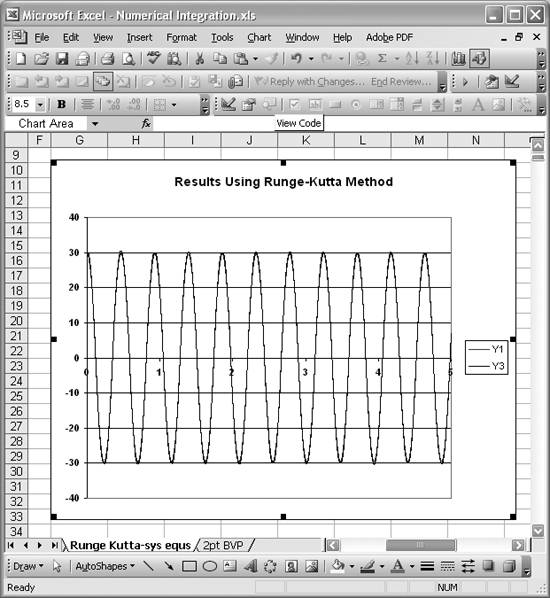Tackling Coupled Equations
Problem
You've seen how to apply both the Runge-Kutta method and Euler's basic method using VBA for first- and second-order differential equations, but now you need to solve a system of coupled equations . You're wondering how to extend what you've learned so far to deal with this more complicated problem.
Solution
You can apply the same VBA techniques discussed earlier with some modifications to deal with multiple equations.
Discussion
Consider this system of coupled nonlinear differential equations with initial conditions:

Pretty, huh? This problem originally consisted of two coupled second-order equations that were reduced to four first-order equations using the same technique discussed in Recipe 11.2. This is a common technique for reducing the order of differential equations, making them more amenable to solving. This particular problem was adapted from a problem that appears in An Introduction to Linear and Nonlinear Finite Element Analysis, by Prem K. Kythe and Dongming Wei (Birkhauser). The problem represents a finite element solution of the nonlinear vibrations of a metal rod. Since this is a nonlinear problem, it requires a numerical solution. In their book, Kythe and Wei present some Matlab code to solve this problem using Euler's method .
Euler's method
I implemented Euler's method in VBA to illustrate how to solve this same system in Excel. Example 11-4 shows my VBA code.
Example 11-4. DoEuler for nonlinear system
Public Sub DoEuler( ) Dim y(1 To 4) As Double Dim t(1 To 4) As Double Dim n As Integer Dim dt As Double Dim time As Double y(1) = 29.8613 y(2) = 0 y(3) = 30.0616 y(4) = 0 n = 5000 dt = 5 / n time = 0 For i = 1 To n t(1) = y(1) + dt * dy1dt(y(1), y(2), y(3), y(4)) t(2) = y(2) + dt * dy2dt(y(1), y(2), y(3), y(4)) t(3) = y(3) + dt * dy3dt(y(1), y(2), y(3), y(4)) t(4) = y(4) + dt * dy4dt(y(1), y(2), y(3), y(4)) y(1) = t(1) y(2) = t(2) y(3) = t(3) y(4) = t(4) time = time + dt ActiveSheet.Cells(i + 1, 1) = time ActiveSheet.Cells(i + 1, 2) = y(1) ActiveSheet.Cells(i + 1, 3) = y(2) ActiveSheet.Cells(i + 1, 4) = y(3) ActiveSheet.Cells(i + 1, 5) = y(4) Next i End Sub |
As you can see, this is not a particularly complicated subroutine. It's very similar to the code in Example 11-2 that I showed you for solving a first-order equation using Euler's method. The major difference in this case is that we have four coupled equations instead of a single equation.
|
I have to confess that there's a little more to this code than is shown in Example 11-4. Notice the function callsdy1dt, dy2dt, dy3dt, dy4dtin the lines of code that implement Euler's integration formula (the lines just after the For statement). These functions compute the derivatives for each y. The derivative expressions are taken directly from the system of equations shown earlier. The corresponding VBA functions are shown in Example 11-5.
Example 11-5. Derivative functions
Public Function dy1dt(y1 As Double, y2 As Double, y3 As Double, y4 As Double) As Double dy1dt = y2 End Function Public Function dy2dt(y1 As Double, y2 As Double, y3 As Double, y4 As Double) As Double dy2dt = (-15600# * (2# * ((Abs(y1)) ^ -0.74) + 3# * ((Abs(y3 - y1))^-0.74))) _ / 7# * y1 + (3# * 15600# * ((Abs(y3 - y1)) ^ -0.74)) / 7# * y3 End Function Public Function dy3dt(y1 As Double, y2 As Double, y3 As Double, y4 As Double) As Double dy3dt = y4 End Function Public Function dy4dt(y1 As Double, y2 As Double, y3 As Double, y4 As Double) As Double dy4dt = (-15600# * (-((Abs(y1)) ^ -0.74) - 5# * ((Abs(y3 - y1)) ^ -0.74))) _ / 7# * y1 - (5# * 15600# * ((Abs(y3 - y1)) ^ -0.74)) / 7# * y3 End Function |
This code runs just fine. The problem is that this is a particularly troublesome system of equations for Euler's method. The solution diverges dramatically as it marches along in time. Check out Figure 11-5 to see what I mean.
The chart shows y1 and y3the displacements of the rod at its center and free endover time. The results should look sinusoidal. However, you can clearly see that this solution is not a sinusoid. This is wonderful example of the sort of problem where Euler's method, though easy to implement, is a poor choice.
Runge-Kutta method
The Runge-Kutta method presents a better alternative to Euler's method for this problem. In Recipe 11.2, I showed you how to reduce a second-order equation to two first-order equations and then use the Runge-Kutta method to solve one and use a Euler step to solve the other. In this new example, I'll show you how to apply the Runge-Kutta method for all four equations at each time step. To this end, I prepared a new subroutine, DoRungeKutta, shown in Example 11-6. DoRungeKutta also makes calls to the derivative functions shown earlier in Example 11-5.
Figure 11-5. Poor results using Euler's method

Example 11-6. Runge-Kutta for nonlinear system
Public Sub DoRungeKutta( ) ' Declar Local variables Dim y(1 To 4) As Double Dim k1(1 To 4) As Double Dim k2(1 To 4) As Double Dim k3(1 To 4) As Double Dim k4(1 To 4) As Double Dim n As Integer Dim dt As Double Dim time As Double Application.ScreenUpdating = False ' Initialize variables y(1) = 29.8613 y(2) = 0 y(3) = 30.0616 y(4) = 0 n = 5000 dt = 5 / n: time = 0 ' Perform iterations For i = 1 To n k1(1) = dt * dy1dt(y(1), y(2), y(3), y(4)) k1(2) = dt * dy2dt(y(1), y(2), y(3), y(4)) k1(3) = dt * dy3dt(y(1), y(2), y(3), y(4)) k1(4) = dt * dy4dt(y(1), y(2), y(3), y(4)) k2(1) = dt * dy1dt(y(1)+k1(1)/2#, y(2)+k1(2)/2#, y(3)+k1(3)/2#, _ y(4)+k1(4)/2#) k2(2) = dt * dy2dt(y(1)+k1(1)/2#, y(2)+k1(2)/2#, y(3)+k1(3)/2#, _ y(4)+k1(4)/2#) k2(3) = dt * dy3dt(y(1)+k1(1)/2#, y(2)+k1(2)/2#, y(3)+k1(3)/2#, _ y(4)+k1(4)/2#) k2(4) = dt * dy4dt(y(1)+k1(1)/2#, y(2)+k1(2)/2#, y(3)+k1(3)/2#, _ y(4)+k1(4)/2#) k3(1) = dt * dy1dt(y(1)+k2(1)/2#, y(2)+k2(2)/2#, y(3)+k2(3)/2#, _ y(4)+k2(4)/2#) k3(2) = dt * dy2dt(y(1)+k2(1)/2#, y(2)+k2(2)/2#, y(3)+k2(3)/2#, _ y(4)+k2(4)/2#) k3(3) = dt * dy3dt(y(1)+k2(1)/2#, y(2)+k2(2)/2#, y(3)+k2(3)/2#, _ y(4)+k2(4)/2#) k3(4) = dt * dy4dt(y(1)+k2(1)/2#, y(2)+k2(2)/2#, y(3)+k2(3)/2#, _ y(4)+k2(4)/2#) k4(1) = dt * dy1dt(y(1) + k3(1), y(2) + k3(2), y(3) + k3(3), y(4) + k3(4)) k4(2) = dt * dy2dt(y(1) + k3(1), y(2) + k3(2), y(3) + k3(3), y(4) + k3(4)) k4(3) = dt * dy3dt(y(1) + k3(1), y(2) + k3(2), y(3) + k3(3), y(4) + k3(4)) k4(4) = dt * dy4dt(y(1) + k3(1), y(2) + k3(2), y(3) + k3(3), y(4) + k3(4)) y(1) = y(1) + (k1(1) + 2 * k2(1) + 2 * k3(1) + k4(1)) / 6 y(2) = y(2) + (k1(2) + 2 * k2(2) + 2 * k3(2) + k4(2)) / 6 y(3) = y(3) + (k1(3) + 2 * k2(3) + 2 * k3(3) + k4(3)) / 6 y(4) = y(4) + (k1(4) + 2 * k2(4) + 2 * k3(4) + k4(4)) / 6 time = time + dt ActiveSheet.Cells(i + 1, 1) = time ActiveSheet.Cells(i + 1, 2) = y(1) ActiveSheet.Cells(i + 1, 3) = y(2) ActiveSheet.Cells(i + 1, 4) = y(3) ActiveSheet.Cells(i + 1, 5) = y(4) Next i Application.ScreenUpdating = True Application.ActiveWorkbook.Save End Sub |
The line Dim y(1 To 4) As Double declares a four-element array variable in which to store the computed ys at every time step. The next several declarations consist of array declarations for the Runge-Kutta k-values. Each of the four equations requires four empty k-values.
After setting the initial y conditions and initializing other utility variables, the subroutine enters a For loop. The guts of the For loop contain a straightforward application of the Runge-Kutta formulas for each equation in the system being solved. As in earlier examples, output is returned to the active spreadsheet at each time step.
Running DoRungeKutta gives much better results than the earlier attempt that used Euler's method. Figure 11-6 shows the new results.
Figure 11-6. Good results using the Runge-Kutta method

These results look far better than those obtained earlier. Clearly, the results shown in Figure 11-6 for y1 and y3 are sinusoidal as expected. The difference between these results and those obtained using Euler's method are dramatic and effectively illustrate the relative accuracy of higher-order methods, such as the Runge-Kutta method, over Euler's basic method.
|
Using Excel
- Introduction
- Navigating the Interface
- Entering Data
- Setting Cell Data Types
- Selecting More Than a Single Cell
- Entering Formulas
- Exploring the R1C1 Cell Reference Style
- Referring to More Than a Single Cell
- Understanding Operator Precedence
- Using Exponents in Formulas
- Exploring Functions
- Formatting Your Spreadsheets
- Defining Custom Format Styles
- Leveraging Copy, Cut, Paste, and Paste Special
- Using Cell Names (Like Programming Variables)
- Validating Data
- Taking Advantage of Macros
- Adding Comments and Equation Notes
- Getting Help
Getting Acquainted with Visual Basic for Applications
- Introduction
- Navigating the VBA Editor
- Writing Functions and Subroutines
- Working with Data Types
- Defining Variables
- Defining Constants
- Using Arrays
- Commenting Code
- Spanning Long Statements over Multiple Lines
- Using Conditional Statements
- Using Loops
- Debugging VBA Code
- Exploring VBAs Built-in Functions
- Exploring Excel Objects
- Creating Your Own Objects in VBA
- VBA Help
Collecting and Cleaning Up Data
- Introduction
- Importing Data from Text Files
- Importing Data from Delimited Text Files
- Importing Data Using Drag-and-Drop
- Importing Data from Access Databases
- Importing Data from Web Pages
- Parsing Data
- Removing Weird Characters from Imported Text
- Converting Units
- Sorting Data
- Filtering Data
- Looking Up Values in Tables
- Retrieving Data from XML Files
Charting
- Introduction
- Creating Simple Charts
- Exploring Chart Styles
- Formatting Charts
- Customizing Chart Axes
- Setting Log or Semilog Scales
- Using Multiple Axes
- Changing the Type of an Existing Chart
- Combining Chart Types
- Building 3D Surface Plots
- Preparing Contour Plots
- Annotating Charts
- Saving Custom Chart Types
- Copying Charts to Word
- Recipe 4-14. Displaying Error Bars
Statistical Analysis
- Introduction
- Computing Summary Statistics
- Plotting Frequency Distributions
- Calculating Confidence Intervals
- Correlating Data
- Ranking and Percentiles
- Performing Statistical Tests
- Conducting ANOVA
- Generating Random Numbers
- Sampling Data
Time Series Analysis
- Introduction
- Plotting Time Series Data
- Adding Trendlines
- Computing Moving Averages
- Smoothing Data Using Weighted Averages
- Centering Data
- Detrending a Time Series
- Estimating Seasonal Indices
- Deseasonalization of a Time Series
- Forecasting
- Applying Discrete Fourier Transforms
Mathematical Functions
- Introduction
- Using Summation Functions
- Delving into Division
- Mastering Multiplication
- Exploring Exponential and Logarithmic Functions
- Using Trigonometry Functions
- Seeing Signs
- Getting to the Root of Things
- Rounding and Truncating Numbers
- Converting Between Number Systems
- Manipulating Matrices
- Building Support for Vectors
- Using Spreadsheet Functions in VBA Code
- Dealing with Complex Numbers
Curve Fitting and Regression
- Introduction
- Performing Linear Curve Fitting Using Excel Charts
- Constructing Your Own Linear Fit Using Spreadsheet Functions
- Using a Single Spreadsheet Function for Linear Curve Fitting
- Performing Multiple Linear Regression
- Generating Nonlinear Curve Fits Using Excel Charts
- Fitting Nonlinear Curves Using Solver
- Assessing Goodness of Fit
- Computing Confidence Intervals
Solving Equations
- Introduction
- Finding Roots Graphically
- Solving Nonlinear Equations Iteratively
- Automating Tedious Problems with VBA
- Solving Linear Systems
- Tackling Nonlinear Systems of Equations
- Using Classical Methods for Solving Equations
Numerical Integration and Differentiation
- Introduction
- Integrating a Definite Integral
- Implementing the Trapezoidal Rule in VBA
- Computing the Center of an Area Using Numerical Integration
- Calculating the Second Moment of an Area
- Dealing with Double Integrals
- Numerical Differentiation
Solving Ordinary Differential Equations
- Introduction
- Solving First-Order Initial Value Problems
- Applying the Runge-Kutta Method to Second-Order Initial Value Problems
- Tackling Coupled Equations
- Shooting Boundary Value Problems
Solving Partial Differential Equations
- Introduction
- Leveraging Excel to Directly Solve Finite Difference Equations
- Recruiting Solver to Iteratively Solve Finite Difference Equations
- Solving Initial Value Problems
- Using Excel to Help Solve Problems Formulated Using the Finite Element Method
Performing Optimization Analyses in Excel
- Introduction
- Using Excel for Traditional Linear Programming
- Exploring Resource Allocation Optimization Problems
- Getting More Realistic Results with Integer Constraints
- Tackling Troublesome Problems
- Optimizing Engineering Design Problems
- Understanding Solver Reports
- Programming a Genetic Algorithm for Optimization
Introduction to Financial Calculations
- Introduction
- Computing Present Value
- Calculating Future Value
- Figuring Out Required Rate of Return
- Doubling Your Money
- Determining Monthly Payments
- Considering Cash Flow Alternatives
- Achieving a Certain Future Value
- Assessing Net Present Worth
- Estimating Rate of Return
- Solving Inverse Problems
- Figuring a Break-Even Point
Index
EAN: 2147483647
Pages: 206

